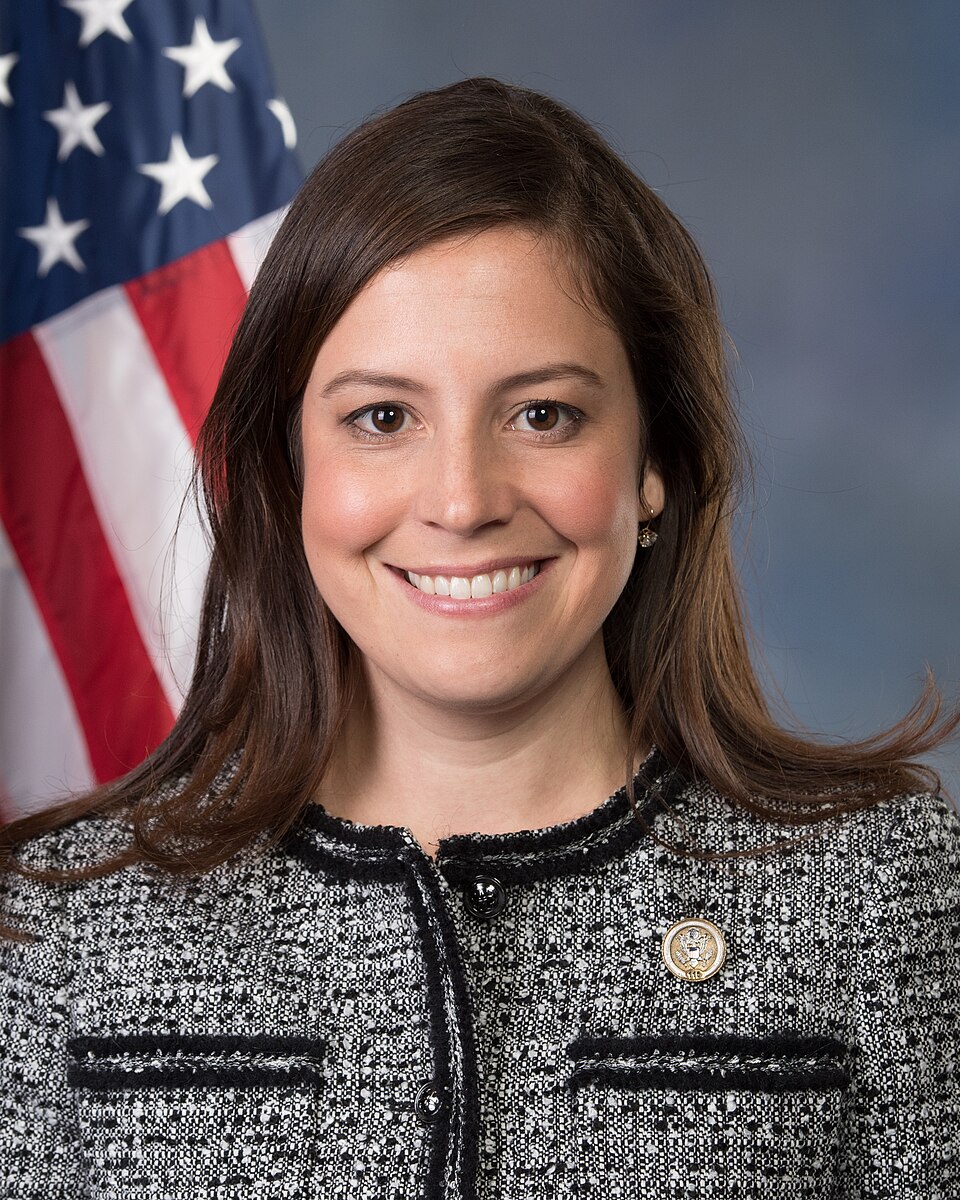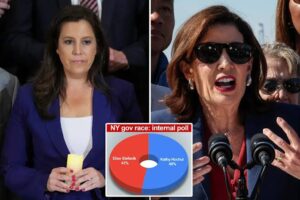Stefanik vs hochul: announces 2026 election,ethnicity,husband,religion

US Representative Elise Stefanik announced on Friday, November 7, 2025. Today we will discuss about Stefanik vs hochul: announces 2026 election,ethnicity,husband,religion
Stefanik vs hochul: announces 2026 election,ethnicity,husband,religion
The next major showdown in New York politics appears to be shaping up between Republican Representative Elise Stefanik and Democratic incumbent Governor Kathy Hochul. On November 7, 2025, Stefanik formally announced her campaign for governor of New York, seeking to challenge Gov. Hochul in the 2026 election.
Stefanik’s announcement video attacked Hochul’s record, branding the incumbent as “the worst governor in America” and declaring her aim to make New York “affordable and safe for all.” Her campaign emphasizes high cost of living, housing unaffordability, energy, and tax burdens as central issues.
On the other side, Hochul has already been in office since 2021 (after the resignation of her predecessor) and won a full term in 2022. Her campaign acknowledges the challenge ahead, with some polls showing a tightening race.
Thus, the race carries both symbolic and practical weight: a Republican challenge in a traditionally Democratic-leaning state, and an incumbent who must defend her record and appeal to a broad electorate under financial and social pressures.
2. Elise Stefanik: Background, Ethnicity, Religion, Family

Early Life & Career
Elise Marie Stefanik was born in Albany, New York, and became the youngest woman ever elected to the U.S. House when she won in 2014. She represents a largely upstate New York district (the 21st) covering portions of the Adirondacks and North Country.
Ethnicity & Cultural Background
Stefanik’s family background is mixed: her mother is of Italian descent, while her father’s ancestry includes Polish and possibly Czech lines. In short, she is Caucasian/white with a mixed European heritage.
Religion
Stefanik is a practicing Roman Catholic. She was raised in the Catholic faith, attended Catholic schools, and maintains family traditions rooted in her father’s Polish heritage. Her faith has been a personal anchor and occasionally referenced in media coverage.
Marital Status and Family
Stefanik married Matthew Manda in August 2017. He works in marketing/communications and later as manager of public affairs for the National Shooting Sports Foundation. The couple has a son, Samuel, born in 2021, and they reside in New York.
Political Positioning
Stefanik has shifted from a more moderate Republican early in her career to a strong alignment with the MAGA wing of the party and former President Donald Trump. Her campaign for governor emphasizes economic issues such as cost, affordability, and safety, but she also carries the baggage of nationalism and partisan alignment, which Hochul’s camp will likely exploit.
3. Kathy Hochul: Background, Ethnicity, Religion, Family
Early Life & Career
Kathleen “Kathy” Hochul was born on August 27, 1958, in Woodlawn near Buffalo, New York. She served as Erie County Clerk, U.S. Representative, Lieutenant Governor of New York, and became Governor in 2021 after the resignation of her predecessor.
Ethnicity & Cultural Background
Hochul comes from an Irish-Catholic family in Buffalo. Her husband, William J. Hochul Jr., has Polish-Catholic immigrant grandparents. While she identifies as Irish American, her broader household includes Central European heritage through her spouse.
Religion
Hochul has spoken openly about her Catholic upbringing and describes herself as a “social justice Catholic.” She has publicly credited her large Irish-Catholic family at her inauguration.
Marital Status and Family
Hochul married William J. Hochul Jr. in 1984. They have two adult children, William III and Caitlin. Her husband is a former U.S. Attorney and currently works in the private sector.
Political Positioning
Hochul is generally considered a moderate Democrat but has had to navigate a very progressive party base in New York. She emphasizes competence, governance, and pragmatic solutions rather than ideological purity.
4. The 2026 Gubernatorial Race: Dynamics, Stakes, Polling
Announcement & Timing
Stefanik’s official campaign announcement on November 7, 2025, signaled her intent to challenge Hochul. Prior to that, she had been exploring a run and positioning herself as the likely Republican challenger.
Hochul, as the incumbent, is gearing up for a re-election effort but faces headwinds: cost of living challenges, voter fatigue, and intra-party dynamics, including a potential primary challenge.
Polling and Competitive Landscape
Recent polling suggests the race may be tighter than expected. Some polls show Stefanik leading Hochul narrowly, while others indicate Hochul ahead initially, but once voters are informed of both candidates’ records, Stefanik edges ahead. These numbers suggest Hochul is vulnerable, particularly among suburban/independent voters and outside of New York City.
Major Issues & Themes
-
Affordability & cost of living: Stefanik emphasizes that New York is “the most unaffordable state” and claims Hochul’s leadership has failed families on housing, energy, and taxes.
-
Safety/crime: Crime and public safety are central to the Republican message, particularly outside New York City and in suburban/upstate areas.
-
Party identity and nationalization: Hochul will seek to tie Stefanik to national Republican priorities and former President Trump, while Stefanik will portray Hochul as aligned with left-wing Democrats and out of step with middle-class New Yorkers.
-
Intra-party dynamics: Hochul may face a primary challenge, which could weaken her position, while Stefanik appears to be the clear GOP frontrunner after other potential rivals declined to run.
Geographic & Demographic Considerations
-
New York City remains a Democratic stronghold; upstate and suburban regions are more competitive and may favor Republican gains.
-
Stefanik’s base is upstate New York; to win statewide, she must make inroads downstate and among independents.
-
Hochul’s vulnerability lies in suburbs and among independents; if she loses ground there, the GOP could be competitive.
5. Head-to-Head: Comparing the Candidates
| Feature | Elise Stefanik | Kathy Hochul |
|---|---|---|
| Party | Republican | Democratic |
| Current Office | U.S. Representative (NY-21) | Governor of New York |
| Announced Run | Yes — 2026 gubernatorial race | Seeking re-election; incumbent |
| Ethnic/Cultural Heritage | Mixed European ancestry: mother Italian, father Polish/Czech; white American | Irish-Catholic family; husband’s family has Polish-Catholic roots |
| Religion | Roman Catholic | Roman Catholic; “social justice Catholic” |
| Marital Status & Family | Married to Matthew Manda (since 2017) with one son | Married to William J. Hochul Jr. (since 1984) with two children |
| Key Campaign Themes | Cost/affordability, safety, conservative national agenda | Governance competence, moderate-progressive mix, defending Democratic majority |
| Strengths | High name recognition among Republicans; strong fundraising; taps into voter dissatisfaction | Incumbency, statewide infrastructure, core Democratic base, executive experience |
| Weaknesses | Needs to appeal beyond GOP base; tied to national party trends which may alienate moderates | Vulnerable among independents/suburbs; must defend record amid cost of living challenges |
6. Implications & What to Watch
Significance of the Race
The Stefanik-Hochul contest will be symbolic: a Republican attempt to flip the governor’s mansion in a deep blue state. Success would signal major shifts in New York politics and potential national implications. For Democrats, retaining the governorship is essential to maintain policy control and influence in national discussions.
Key Variables
-
Primary challengers: Any meaningful challenge within either party could drain resources.
-
Geographic performance: Stefanik must expand downstate; Hochul must defend suburban areas.
-
Independent voters and turnout: Swing voters may decide the election.
-
Economic concerns: Cost of living, housing, taxes, energy prices are central.
-
National political climate: Stefanik’s ties to the national GOP may help or hurt depending on broader trends.
-
Campaign resources & strategy: Fundraising, messaging, and organization will be critical.
What to Watch in 2025-2026
-
Campaign announcements, running mates, and platforms
-
Polls showing shifts in suburban and independent voter sentiment
-
Fundraising reports and endorsements
-
Developments in housing, crime, taxes, and cost of living
-
Turnout patterns in the November 2026 election
7. Conclusion
The 2026 New York gubernatorial contest between Elise Stefanik and Kathy Hochul is poised to be one of the most watched state races in the country. Stefanik seeks to flip the seat and capitalize on voter frustration around affordability and safety. Hochul must defend her record, bridge suburban/independent gaps, and avoid being drawn into nationalized partisan battles.
Both candidates bring rich personal biographies that matter in campaigns: Stefanik’s mixed European heritage, Catholic faith, and youth-in-Congress narrative; Hochul’s Irish-Catholic upbringing, legal and public service background, and status as New York’s first female governor. These elements will be leveraged by both sides in shaping voter perceptions of authenticity, values, and leadership.
For New York voters and political observers, the evolving dynamics of this race will reveal much about the state’s political mood heading into the mid-2020s. Will the Republican challenger succeed in a blue state? Can the Democratic incumbent reassert her strength amid changing demographics and frustrations? The campaign ahead will determine not just who holds the governor’s mansion, but which direction New York chooses for governance, policy, and identity.
How useful was this post?
Click on a star to rate it!
Average rating 0 / 5. Vote count: 0
No votes so far! Be the first to rate this post.
About the Author
usa5911.com
Administrator
Hi, I’m Gurdeep Singh, a professional content writer from India with over 3 years of experience in the field. I specialize in covering U.S. politics, delivering timely and engaging content tailored specifically for an American audience. Along with my dedicated team, we track and report on all the latest political trends, news, and in-depth analysis shaping the United States today. Our goal is to provide clear, factual, and compelling content that keeps readers informed and engaged with the ever-changing political landscape.




